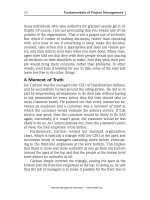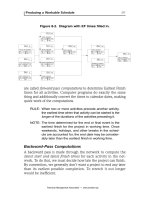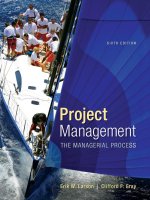Exploring management 6th by schermerhornch12
Bạn đang xem bản rút gọn của tài liệu. Xem và tải ngay bản đầy đủ của tài liệu tại đây (432.15 KB, 41 trang )
Exploring
Management
John R. Schermerhorn, Jr. and Daniel G. Bachrach
Sixth Edition
Chapter 12
Individual Behavior
You don’t have to look in a
mirror to gain more selfawareness. What does
your smart phone, tablet,
or computer screen say
about your personality?
Copyright ©2018 John Wiley & Sons, Inc.
2
Your Chapter 12 Takeaways
• Understand how perceptions influence
individual behavior. (12.1)
• Understand how personalities influence
individual behavior. (12.2)
• Understand how attitudes, emotions, and
moods influence individual behavior.(12.3)
Copyright ©2018 John Wiley & Sons, Inc.
3
PERCEPTIONS 12.1
Takeaway 12.1 – answers to come
• Perception filters information received
from our environment.
• Perceptual distortions can obscure
individual differences.
• Perception can cause attribution errors as
we explain events and problems.
• Impression management influences how
others perceive us.
Copyright ©2018 John Wiley & Sons, Inc.
4
PERCEPTIONS 12.1
Perceptual Distortions
FIGURE 12.1 How Does Perception Influence Communication?
Copyright ©2018 John Wiley & Sons, Inc.
5
PERCEPTIONS 12.1
Common Perceptual Distortions
• Stereotypes
• Using limited attributes of a group to describe an
entire group or individuals in the group
• Halo effect
• Using one characteristic of a person to form an
overall impression
• Selective perception
• Limit perception of information to that which agrees
with existing beliefs
• Projection
• Assign our personal attributes to another individual
Copyright ©2018 John Wiley & Sons, Inc.
6
PERCEPTIONS 12.1
Perception can Cause Attribution Errors
• Attribution
• Developing explanations or causes for events
• Fundamental attribution error
• Tendency to blame someone else when things
go wrong
• Self-serving bias
• Blame personal problems on external causes
rather than accept personal responsibility
Copyright ©2018 John Wiley & Sons, Inc.
7
PERCEPTIONS 12.1
Impression Management
• Impression management
• The systematic attempt to influence how others
perceive us
• Impression management that is well done can help
us to advance in jobs and careers, form relationships
with people we admire, and even create pathways to
desired social member-ships.
Copyright ©2018 John Wiley & Sons, Inc.
8
PERCEPTIONS 12.1
Study Guide for Takeaway 12.1
Rapid Review:
• Perception acts as a filter through which all communication passes as
it travels from one person to the next.
• Different people may perceive the same things differently.
• Stereotypes, projections, halo effects, and selective perception can
distort perceptions and reduce communication effectiveness.
• Fundamental attribution error occurs when we blame others for their
performance problems, without considering possible external causes.
• Self-serving bias occurs when, in judging our own performance, we
take personal credit for successes and blame failures on external
factors.
• Through impression management, we influence the way that others
perceive us.
Copyright ©2018 John Wiley & Sons, Inc.
9
PERCEPTIONS 12.1
Study Guide for Takeaway 12.1
Questions for Discussion:
1. How do advertising firms use stereotypes
to influence consumer behavior?
2. Are there times when a self-serving bias
is actually helpful?
3. Does the notion of impression
management contradict the idea of
personal integrity?
Copyright ©2018 John Wiley & Sons, Inc.
10
PERCEPTIONS 12.1
Be Sure You Can…for Takeaway 12.1
• describe how perception influences behavior.
• explain how stereotypes, halo effects, selective
perceptions, and projection might operate in the
workplace.
• explain the concepts of attribution error and selfserving bias.
• illustrate how someone might use impression
management during a job interview.
Copyright ©2018 John Wiley & Sons, Inc.
11
PERSONALITIES 12.2
Takeaway 12.2 – answers to come
• The Big Five personality traits describe important
individual differences.
• The Myers-Briggs Type Indicator is a popular
approach to personality assessment.
• Personalities vary on personal conception traits.
• People with Type A personalities tend to stress
themselves.
• Stress has consequences for work performance
and personal health.
Copyright ©2018 John Wiley & Sons, Inc.
12
PERSONALITIES 12.2
Personality Traits
• Personality
• Combination of characteristics that
make us unique individuals
• This uniqueness can have
consequences for how we behave
and how that behavior is regarded
by others.
Copyright ©2018 John Wiley & Sons, Inc.
13
PERSONALITIES 12.2
The “Big Five” Personality Traits
Extraversion
An extrovert is talkative, comfortable, and confident in interpersonal
relationships; an introvert is more private, withdrawn, and reserved.
Agreeableness
An agreeable person is trusting, courteous, and helpful, getting along well with
others; a disagreeable person is self-serving, skeptical, and tough, creating
discomfort for others.
Conscientiousness
A conscientious person is dependable, organized, and focused on getting things
done; a person who lacks conscientiousness is careless, impulsive, and not
achievement-oriented.
Emotional stability
A person who is emotionally stable is secure, calm, steady, and self-confident; a
person lacking emotional stability is excitable, anxious, nervous, and tense.
Openness to
Experience
A person open to experience is broad-minded, imaginative, and open to new
ideas; a person who lacks openness is narrow-minded, has few interests, and
resists change
Copyright ©2018 John Wiley & Sons, Inc.
14
PERSONALITIES 12.2
Myers-Brigg Type Indicator
• A popular approach to personality assessment
• uses a sophisticated questionnaire to examine how
people act or feel in various situations
• Developed from foundations from psychologist Carl
Jung
• Examines differences in the way people relate with
others
• Examines how people gather information
• Examines how people evaluate information
Copyright ©2018 John Wiley & Sons, Inc.
15
PERSONALITIES 12.2
Myers-Brigg Type Indicator
• Myers-Briggs Four Personality Types
• Extraversion vs. introversion (E or I—whether a person
tends toward being outgoing and sociable or shy and quiet
• Sensing vs. intuitive (S or N)—whether a person tends to
focus on details or on the big picture in dealing with
problems
• Thinking vs. feeling (T or F)—whether a person tends to
rely on logic or emotions in dealing with problems
• Judging vs. perceiving (J or P)—whether a person prefers
order and control or acts with flexibility and spontaneity
Copyright ©2018 John Wiley & Sons, Inc.
16
PERSONALITIES 12.2
Personality Traits
Sample Myers-Briggs Personality Types
• ESTJ (extraverted, sensing, thinking, judging)—practical,
decisive, logical, and quick to dig in; common among
managers
• ENTJ (extraverted, intuitive, thinking, judging)—analytical,
strategic, forceful, quick to take charge; common for leaders
• ISFJ (introverted, sensing, feeling, judging)—conscientious,
considerate, and helpful; common among team players
• INTJ (introverted, intuitive, thinking, judging)—insightful,
free-thinking, determined; common for visionaries
Copyright ©2018 John Wiley & Sons, Inc.
17
PERSONALITIES 12.2
Personalities Vary
• Authoritarianism
• Respect authority
• Machiavellianism
• Manipulate others to achieve goals
• Self monitoring
• Open to feedback
• Able to adjust to changing situations
Copyright ©2018 John Wiley & Sons, Inc.
18
PERSONALITIES 12.2
Personality Traits
Copyright ©2018 John Wiley & Sons, Inc.
19
PERSONALITIES 12.2
Type A Personalities Stress Themselves
• Stress
• A state of tension experienced by individuals facing
extraordinary demands, constraints or
opportunities
• Type A personalities
• High achievement orientation
• Creates own stress
Copyright ©2018 John Wiley & Sons, Inc.
20
PERSONALITIES 12.2
Stress Has Consequences
• Stress
• Tension when faced with demands, constraints and
opportunities
• Constructive stress
• Destructive stress
• Job burnout
• physical and mental exhaustion from work stress
• A flameout
• occurs when we communicate extreme agitation in
interpersonal relationships or electronic messages
• Workplace rage
• aggressive behavior toward co-workers or the work
setting
Copyright ©2018 John Wiley & Sons, Inc.
21
PERSONALITIES 12.2
Personality Traits
• Locus of Control
• Internal
• Personal control over success and failure
• “If it is to be, it’s up to me!”
• External
• Little personal control
• “What happens, happens.”
Copyright ©2018 John Wiley & Sons, Inc.
22
PERSONALITIES 12.2
Stress Has Consequences
Copyright ©2018 John Wiley & Sons, Inc.
23
PERSONALITIES 12.2
Personal Wellness
• Personal Wellness
• pursuit of a personal health-promotion
program
• Helps cope with stress and job demands
• Rest
• Exercise
• Eating right
• Healthy habits
Copyright ©2018 John Wiley & Sons, Inc.
24
PERSONALITIES 12.2
Study Guide for Takeaway 12.2
Rapid Review:
• The Big Five personality factors are extraversion, agreeableness,
conscientiousness, emotional stability, and openness.
• The Myers-Briggs Type Indicator identifies personality types based on
extraversion-introversion, sensing-intuitive, thinking-feeling, and judgingperceiving.
• Additional personality dimensions of work significance are locus of control,
authoritarianism, Machiavellianism, self-monitoring, and Type A orientation.
• Stress is a state of tension that accompanies extraordinary demands,
constraints, or opportunities.
• For some people, having a Type A personality creates stress as a result of
continual feelings of impatience and pressure.
• Stress can be destructive or constructive; a moderate level of stress can have a
positive impact on performance.
Copyright ©2018 John Wiley & Sons, Inc.
25









